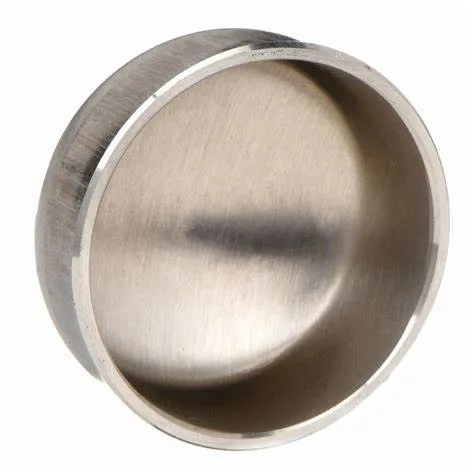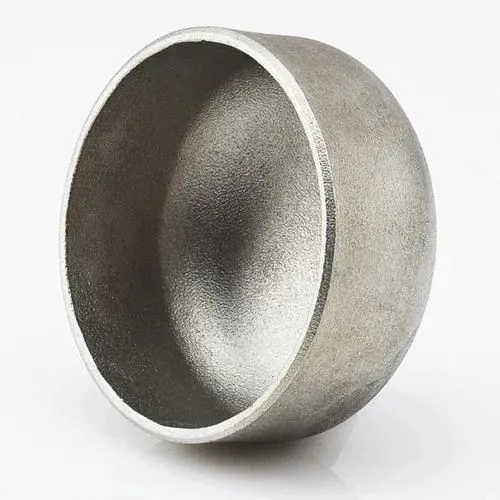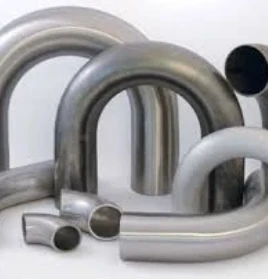JIS B2311 - гэта японскі прамысловы стандарт, які ахоплівае фітынгі для трубаправоднай зваркі, уключаючы каўпачкі, якія выкарыстоўваюцца ў сістэмах трубаправодаў. Заглушкі для стыкавой зваркі служаць для закрыцця канца трубы, забяспечваючы герметычнасць для прадухілення ўцечкі або забруджвання. Вось уводзіны ў JIS B2311 для стыкавой зваркі:
- 1. JIS B2311 Standard:
- - Стандарт JIS B2311 вызначае патрабаванні да канструкцыі, памераў, матэрыялаў, вырабу і выпрабаванняў фітынгаў для стыкавой зваркі, уключаючы каўпачкі, у сістэмах трубаправодаў.
- - Стандарт гарантуе, што каўпачкі, вырабленыя ў адпаведнасці са стандартамі JIS, адпавядаюць стандартам якасці і сумяшчальныя з іншымі кампанентамі трубаправодаў.
- 2. Крышка для стыкавой зваркі:
- - Заглушка для стыкавой зваркі, у адпаведнасці з JIS B2311, - гэта фітынг, прызначаны для надзейнага пакрыцця і герметызацыі канца трубы, забяспечваючы абарону і захаванне цэласнасці сістэмы трубаправодаў.
- - Заглушкі выкарыстоўваюцца ў сітуацыях, калі канец трубы патрабуе закрыцця, назаўсёды або часова, каб прадухіліць уцечку, забруджванне або забяспечыць аздабленне сістэмы.
- 3. Матэрыял і канструкцыя:
- - Крышкі для стыкавой зваркі ў адпаведнасці са спецыфікацыямі JIS B2311 даступныя з розных матэрыялаў, такіх як вугляродзістая сталь, нержавеючая сталь і легаваная сталь, каб адпавядаць розным патрабаванням прымянення.
- - Гэтыя заглушкі вырабляюцца з выкарыстаннем стандартызаваных метадаў канструкцыі, каб забяспечыць трывалае злучэнне без уцечак пры прыварванні да канца трубы.
- 4. Ужыванне і перавагі:
- - Заглушкі для стыкавой зваркі знаходзяць прымяненне ў розных галінах прамысловасці, у тым ліку ў нафтавай і газавай прамысловасці, хімічных працэсах, водаачышчальных збудаваннях і інш., дзе канцы труб трэба надзейна зачыніць.
- - Заглушкі забяспечваюць абарону канцоў труб ад уздзеянняў навакольнага асяроддзя, прадухіляюць забруджванне і дапамагаюць падтрымліваць чысціню і цэласнасць сістэмы трубаправодаў.
- 5. Мантаж і зварка:
- - Правільная практыка ўстаноўкі, у тым ліку правільнае выраўноўванне, падрыхтоўка канца трубы і метады зваркі, вельмі важныя пры ўсталёўцы вечкаў для стыкавой зваркі, каб забяспечыць шчыльнае і герметычнае ўшчыльненне.
- - Зварка з'яўляецца агульным метадам для мацавання заглушак да труб, забяспечваючы надзейнае і пастаяннае закрыццё, якое можа супрацьстаяць ціску, тэмпературным зменам і патоку вадкасці ў сістэме.
- Падводзячы вынік, JIS B2311 заглушкі для стыкавой зваркі з'яўляюцца найважнейшымі кампанентамі, якія выкарыстоўваюцца ў сістэмах трубаправодаў для надзейнай герметызацыі і абароны канцоў труб. Гэтыя каўпачкі адпавядаюць стандартызаваным патрабаванням для забеспячэння якасці, надзейнасці і сумяшчальнасці ў прамысловых прымяненнях, дзе неабходны закрыццё і абарона труб.
What Is a Butt Welding Cap and How Is It Used in Industrial Piping?
In industrial piping systems, end-of-line sealing and branch closures require robust solutions. A butt welding cap serves as a critical component for terminating pipes securely. By providing a seamless, welded closure, this fitting maintains system integrity, prevents leaks, and supports compliance with industry standards.
What Is a Butt Welding Cap?
A butt welding cap—also called a pipe end cap or buttweld end cap—is a round fitting designed to close off the end of a pipe. It’s manufactured to match the pipe’s outer diameter and schedule, with either a hemispherical or flat face. To install, both the pipe end and cap are beveled to form a V‑groove, enabling full‑penetration, fusion welds. Common materials include carbon steel, stainless steel, nickel alloys, and other engineered grades, chosen to satisfy pressure, temperature, and corrosion‑resistance requirements.
How Is Butt Welding Cap Used in Industrial Piping?
Butt welding caps find application across oil & gas, petrochemical, power generation, water treatment, and general process industries for both permanent and temporary closures. During hydrostatic testing, technicians install caps to seal off sections of piping while monitoring for leaks. In new construction or retrofit projects, caps terminate branch lines, future tie‑in spools, or dead‑end mains until system expansion. Welders prepare each joint by cleaning and beveling surfaces, aligning the cap precisely, and executing a root pass followed by filler passes per the qualified Welding Procedure Specification (WPS). Post‑weld heat treatment and non‑destructive examination (NDE)—such as radiography or ultrasonic testing—verify weld integrity and compliance with ASME B16.9 and related standards. Additionally, temporary caps enable safe isolation during maintenance, allowing for segment testing and dewatering under regulatory protocols.
Benefits and Best Practices
Butt welding caps offer a smooth‑bore transition that minimizes flow disruption and stress concentration. Their full‑penetration welds deliver exceptional structural strength and leak resistance. To optimize performance, engineers should:
Select caps with matching material grades and wall thicknesses
Adhere to proper bevel angles and joint fit‑up tolerances
Follow qualified WPS protocols rigorously
Consider cladding or protective coatings in corrosive environments to extend service life
Regular inspection and thorough documentation ensure long‑term reliability and safe operation under demanding conditions.
Butt welding caps are indispensable components for achieving durable, leak‑proof pipe terminations in a wide range of industrial applications.
Butt Welding Cap FAQs
What is a butt welding cap?
|
What materials are commonly used?
|
What standards govern butt welding caps?
|
How are butt welding caps installed?
|
Where are butt welding caps typically used?
|
What are the advantages of threaded caps?
|
















